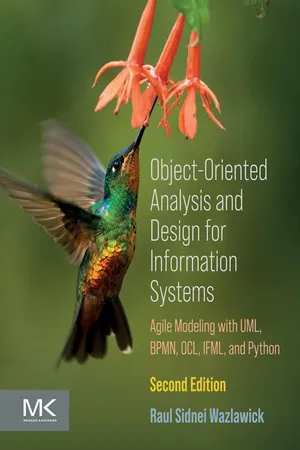
Object-Oriented Analysis and Design for Information Systems
Modeling with BPMN, OCL, IFML, and Python
- 420 pages
- English
- ePUB (mobile friendly)
- Available on iOS & Android
Object-Oriented Analysis and Design for Information Systems
Modeling with BPMN, OCL, IFML, and Python
About This Book
Object-Oriented Analysis and Design for Information Systems, Second Edition clearly explains real object-oriented programming in practice. Expert author Raul Sidnei Wazlawick explains concepts such as object responsibility, visibility, and the real need for delegation in detail. The object-oriented code generated by using these concepts in a systematic way is concise, organized and reusable.The patterns and solutions presented in this book are based in research and industrial applications. You will come away with clarity regarding processes and use cases and a clear understanding of how to expand a use case. Wazlawick clearly explains how to build meaningful sequence diagrams. Object-Oriented Analysis and Design for Information Systems illustrates how and why building a class model is not just placing classes into a diagram. You will learn the necessary organizational patterns so that your software architecture will be maintainable. The Second Edition includes all new content shifting the focus of the book to agile software development, including Scrum software project management, BPMN diagrams, user stories, and Python code examples.
- Provides updates on how to build better class models, which are more maintainable and understandable
- Explains how to write use cases in a more efficient and standardized way, using more effective and less complex diagrams
- Updates on how to build true object-oriented code with division of responsibility and delegation
- Covers contemporary themes such as agile methodologies and BPMN (Business Process Modeling and Notation)
Frequently asked questions
Information
Table of contents
- Cover image
- Title page
- Table of Contents
- Copyright
- 1. Introduction
- 2. General view of the system
- 3. Business modeling
- 4. High-level requirements
- 5. Use case-based project planning
- 6. Expanded use cases
- 7. System operations
- 8. Conceptual modeling: fundamentals
- 9. Conceptual modeling: data structures and organization
- 10. From use cases to conceptual model
- 11. Conceptual modeling: patterns
- 12. Functional modeling with object constraint language contracts
- 13. Domain tier design
- Chapter 14. Code generation
- 15. Testing
- 16. Interface tier design
- 17. Data persistence
- Bibliography
- Index